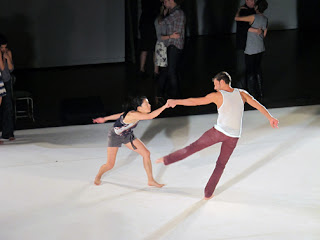Here's a great idea. Let's create a museum dedicated to contemporary art. In fact let's be so dedicated to contemporary art, that we're not going to have a permanent collection. Once a year, we'll change out everything in the museum with completely new stuff that we don't own.
The egos of most museums would prevent them from taking such a position. But that's exactly the idea behind Denver's Museum of Contemporary Art (MCA). In fact, if you talk to the gallery attendants or the super-friendly woman at the gift shop, they can tell you by name the entire permanent collection of the museum which includes a total of three works. (OK, there are technically more than three since the work in the cafe includes a number of ceramic sculptures by the same artist.)
One of the works in the permanent collection is brilliant and by a duo of my favorite artists. Tim Noble and Sue Webster are most notorious for their chaotic sculptures that create simplified silhouettes when lit with a spotlight. A perfect example is the
penis sculpture I recently saw at the New Museum. In Denver, they've created a spectacular lighted bleeding heart called
Toxic Schizophrenia (Hyper Version) that resides outside the museum. I'll definitely be visiting this sculpture at night on my next visit to Denver. I love it. Can I please get a giant, lighted bleeding heart in front of my house.


But we're not here to talk about the permanent collection because that's not what this museum is about. Before I get to the exhibit, I have to make a quick comment about the entrance to the museum. I seriously couldn't figure out how to get in. There isn't a door. Fortunately, I walked far enough into the walkway that I triggered the motion sensors. And suddenly a massive metal wall glided open to let me in. That alone made me love MCA Denver.
The exhibit that was on display (unfortunately it closed shortly after my visit so you can't see it) was Energy Effects: Art and Artifacts from the Landscape of Glorious Excess. This was a great show that tries to tackle our endless appetite for energy and power, and how that desire has led to an orgy of excess.
I loved Jeff Shore and Jon Fisher's Cliff Hanger (2009; 5 mins. 20 secs.; wood, wire, plastic aluminum, cameras, motors, guitar strings, drawer glide, light bulbs, custom electronics, computer, monitor, speakers and button). You press a button and set in motion a unique movie that is created from the strange, Rube-Golbergian contraption that reminds us how complex our lives have become.
On the other side of complex, there's Viviane le Courtois's Chaussures (1991 - present; fiber). Viviane hand makes her own flip-flops from natural fibers. She wears them until they begin to disintegrate. The whole time she writes about what happened while wearing her rustic sandals. At MCA, hundreds of her worn-out footwear are on display. It's a reminder that energy and power are fueled by real people, not by oil or gas or wind.
One of the surprises of this show was it's willingness to embrace objects some wouldn't call art. Take the B61 Thermonuclear Bomb (1968 - present; two of an estimated 3,155 original models) from the Los Alamos National Laboratory. Seriously, anytime I can go to an art museum and confront real, live nuclear bombs, I'm thrilled. This is scary stuff. Shouldn't we be taking this more seriously. It was a perfect reminder that we're intent on wiping out our own species.
If the whole idea behind this museum wasn't intoxicating enough, they have one other surprise. In the library, many of the artists who have shown works at the museum have left a souvenir behind; a reminder of their time at the museum. It's a wonderful bit of contemporary art-world love. Tiny, strange items that say more about the experience of art than the commercialism of art. It's a wonderful idea.
Here's Felix wandering the library:
And here are two doll-like self portraits left behind by Tim Noble and Sue Webster. This makes me want to invite artist friends over in hopes that they'll leave a little something behind in my home.





















































